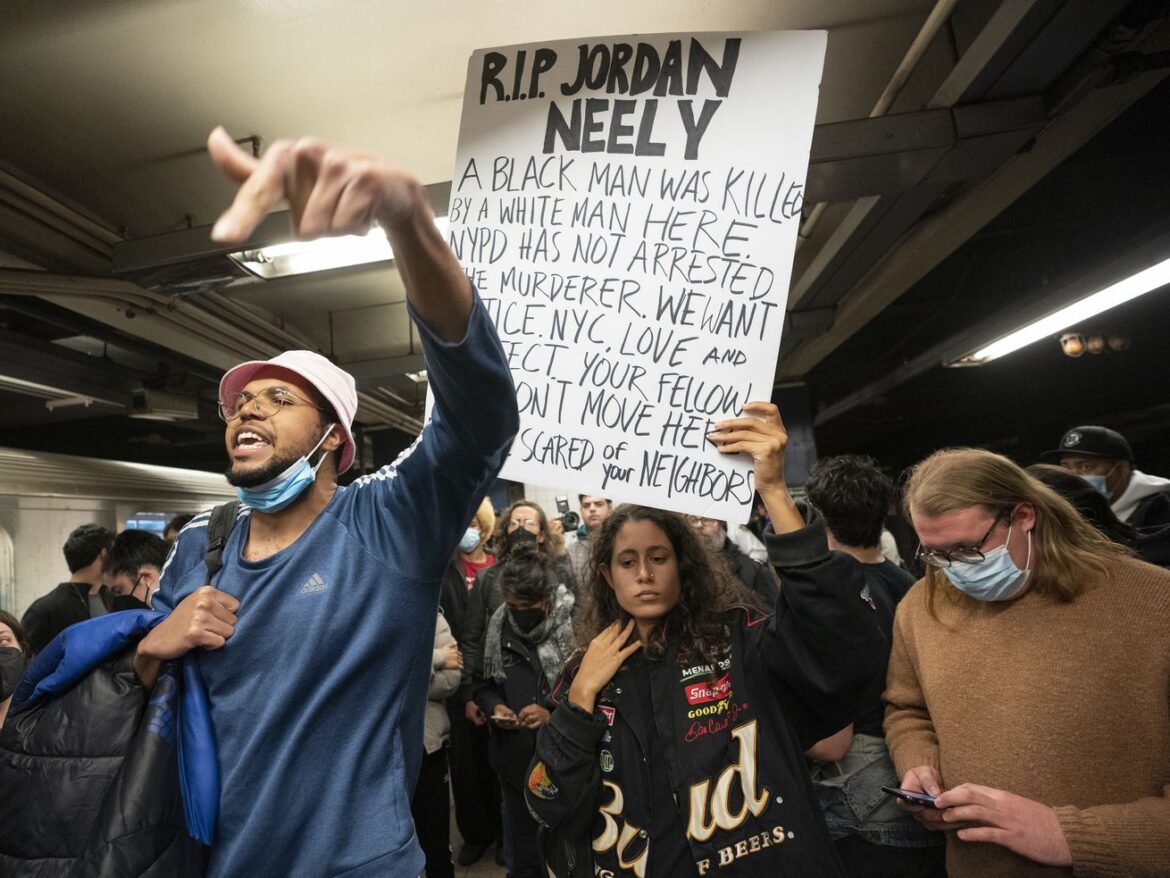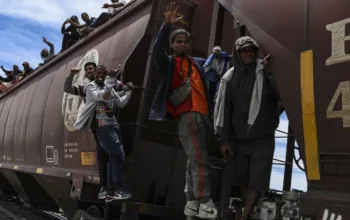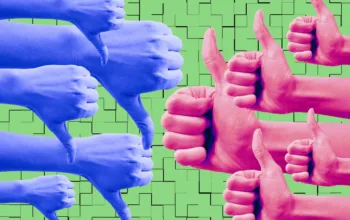The tragic killing came in a climate of fearmongering and New York City’s long failure to support people experiencing homelessness.
On Monday, Jordan Neely, a 30-year-old Black, unhoused man experiencing mental health issues, was killed after being put in a chokehold for 15 minutes by a fellow New York City subway passenger. On Wednesday, the city medical examiner ruled Neely’s death a homicide, and the killing has spurred widespread outrage as the subway rider who choked Neely, who has yet to be identified, was released without charges.
The Manhattan district attorney’s office is considering whether to bring charges against the subway rider, who is reportedly a white 24-year-old former Marine, but authorities had not taken him into custody as of Wednesday night.
According to one eyewitness, who posted a video of the altercation on his Facebook page, Neely had allegedly yelled that he did not have food or something to drink, that he was ready to die, and that he didn’t care about facing life in prison. But that eyewitness also told the New York Post that Neely did not attack anyone in the car.
There’s still a lot we don’t know about the case, but it has already brought to the forefront several of the systemic issues New York and the country are confronting: crime rates, fears about crime, and how politicians are exploiting those fears seem likely to have played a role. For those who have gathered in the subway to protest Neely’s killing this week, he’s become a symbol of New York City’s failure to provide an adequate safety net to vulnerable individuals and protect them from criminalization. Racial justice advocates have also called out the delays in the city’s decision to pursue charges against the 24-year-old subway rider as the latest example of violence toward Black Americans seemingly being condoned by the criminal justice system.
“This is about much more than just this one specific case,” said Bill Neidhardt, a Democratic strategist based in New York. “There’s a clear throughline between the endless demonization of unhoused people and mentally ill people and also the relentless campaign to fan the flames of fear about crime in the city.”
Some city officials have declined to condemn the man who killed Neely while the law enforcement investigation is ongoing and also declined to discourage other subway passengers from similarly taking matters into their own hands: “Each situation is different … We cannot just blanketly say what a passenger should or should not do in a situation like that,” New York City Democratic Mayor Eric Adams told CNN Wednesday.
“I think [what happened to Jordan Neely] is yet another example of a whole host of responses we have to people who are experiencing homelessness, people with serious psychiatric impairments, race, fear, the jump to ‘my safety, you’re a threat.’” says Kendall Atterbury, a social work expert affiliated with Yale School of Medicine’s Program for Recovery and Community Health. “It’s unconscionable that we keep allowing this to happen.”
Crime messaging in New York put the public on edge
Some have come to the 24-year-old man’s defense, saying his actions were justified, and some media coverage has painted Neely as the aggressor. Headlines from local news outlets Wednesday described Neely as the “Man Who Threatened NYC Subway Riders” and “Man Harassing NoHo Subway Riders” and declared that the rider had tried to “Subdue Him.”
There is no evidence that Neely had become violent. And those headlines assume that Neely would have become violent if his fellow subway rider had not intervened — assumptions that are, experts say, rooted in years of political fearmongering over a pandemic spike in violent crime in New York City. That wave of violent crime has subsided, but nonviolent crimes were up in 2022 and at the forefront of New York state voters’ minds in the midterms.
“When politicians constantly use New York City as the emblem of danger and violence and they exploit that to motivate their voters, why would we be shocked that people in New York are walking around on pins and needles and afraid all the time?” said Jeffrey Butts, a professor and director of the Research and Evaluation Center at the John Jay College of Criminal Justice.
As was the case across much of the US in 2020, the murder rate jumped significantly — by about 47 percent — in New York City. Though murders were still about 80 percent below their peak in 1990, New Yorkers had well-founded concerns that their city was less safe than it had been just a few years ago. Adams, a Democrat and former NYPD cop, rode a “tough on crime” message to win the city’s mayoral race in 2021.
By the end of 2022, city homicides had fallen to their lowest levels since the onset of the pandemic, though a surge in robberies and burglaries contributed to a 22 percent rise in overall crime since the previous year. That wasn’t enough to assuage voters’ concerns, which had been fed by New York City tabloid coverage, turning them into a full-blown “crime panic,” said Gabe Tobias, a Democratic strategist based in New York.
With headlines likening the city to Blade Runner and asking, “Will No One Help Us?” amid concerns about public safety, publications like the New York Post were amplifying the spike in crimes and individual crimes, including other violent attacks on the subway system in Manhattan.
Crime in New York City became the subject of almost 800 stories in digital and print outlets each month after Adams’s inauguration, compared to an average of 132 stories monthly under his predecessor Bill de Blasio.
What many of those stories failed to get across was the critical context that New York was still a lot safer than many other parts of America and that the city’s violent crime levels were not nearly as high as they have been historically and had abated substantially in the years since 2020.
“It was certainly a big increase, and it was almost an overnight increase. But historically, it was nowhere near where it was when New York was having 2,000-plus murders in a year,” said Jeff Asher, co-founder of the criminal justice data firm AH Datalytics.
For more than two decades, New York City’s murder rate has been consistently at or below the national average, which is extraordinary for a city of its size, Asher said. Shootings are down 23 percent this year. The per capita violent crime rate in New York City is also lower than in many small towns in the South, Butts said. (New York City remains safer than other big cities and safer than small-town America, Bloomberg’s Justin Fox noted last year.)
“People are bad at perceiving crime trends. And they’re especially bad at perceiving crime trends while they’re in the middle of them,” Asher said. “And so when you have highly public incidents, it can give people a false impression of what the overall big picture trends look like.”
Experts worry that Neely’s killing is, in part, a result of relentless political rhetoric that has contributed to the public’s incomplete understanding of actual crime levels, and that by refusing to outright condemn the killer, Adams is perpetuating that rhetoric. “Someone committed murder on the subway in broad daylight,” Neidhardt said. “You should be able to acknowledge what happened here.”
Neely’s killing renews scrutiny on NYC’s treatment of unhoused people
Neely’s killing has also raised new attention on the way that people experiencing homelessness have been treated both by the city and its residents. Advocates have been working for years to close gaps in mental health support and end punitive treatment of unhoused people. And the release of the man who conducted the fatal chokehold has prompted outcry given the message it sends about his actions.
“The fact that someone who took the life of a distressed, mentally ill human being on a subway could be set free without facing any consequences is shocking and evidences the city’s callous indifference to the lives of those who are homeless and psychiatrically unwell,” Dave Giffen, the executive director of the Coalition for the Homeless, said in a statement.
A 2016 United Nations report highlighted how people experiencing homelessness are subject to “inhumane and degrading treatment” both by the government and by private citizens. And according to a 2020 study published in The Lancet, unhoused people are at much higher risk of being the victims of crime and violence than people who are housed. Narratives about unhoused people being “dangerous” also spur a “climate of fear,” advocates say.
In recent years, there’s been a growing focus on such stories amid high-profile instances of unhoused people being involved in violence in cities including New York City. The increased homelessness in the city, where it’s at the highest levels since the Great Depression, has also drawn attention to these concerns. Advocates note that it’s important not to make sweeping statements, however, and stress that unhoused people are more likely to be the target than the perpetrators of fatal violence.
Experts have also criticized New York City’s plan to implement an involuntary hospitalization policy for people who are navigating serious mental illness. That proposal enables law enforcement and other government employees to hospitalize unhoused people who appear to be undergoing a mental health crisis. Those who’ve studied the issue say that it doesn’t provide a durable solution to challenges people may be having with mental illness and lack of housing.
“It’s a short-term solution, but it’s one that’s been shown not to work,” says Deborah Padgett, an NYU social work professor who has studied homelessness. “In a matter of days, these people are going to be back on the street and no better.” Mayor Adams touted the city’s commitment to mental health resources in a statement this week, noting that it was making “record investments in providing care to those who need it.”
Broadly, experts note that the reaction lawmakers across the country have had to homelessness has been focused on penalizing those who are unhoused and on reducing their visibility, when the focus should be on providing stable housing outside of shelters.
“Punitive police responses focusing on behaviors associated with homelessness — including everything from encampment visibility, to sleeping in public, to public displays of mental illness — is one of, if not the most common, response to homelessness across the country,” Charley Willison, a Cornell public health professor who studies the issue, told Vox. “Extensive previous research has shown that punitive responses do not end homelessness, and actually facilitate cycles of homelessness.”
Instead, Willison and Padgett note, increasing units of affordable housing and providing support services for people in these places has been proven to work.
According to the Coalition for the Homeless, nearly 69,000 unhoused people spent each night in one of the city’s shelters in December 2022. “The bottom line is the lack of affordable housing, and so little has been done in that area for the last 30 to 40 years,” says Padgett.
How Black Americans are treated as threats
The fatal violence toward Neely, and the release of the white Marine who perpetrated it, also points to how such attacks on Black people have been treated differently by the criminal justice system. Multiple racial justice advocates including Rev. Al Sharpton have urged authorities to consider manslaughter or murder charges. As the New York Times reported, under New York law, “a person can only use deadly physical force if they have reason to believe that an attacker is doing or about to do the same.”
“Racism that continues to permeate throughout our society allows for a level of dehumanization that denies Black people from being recognized as victims when subjected to acts of violence,” New York City Council Speaker Adrienne Adams said in a statement.
In multiple cases, including the shooting of teenager Ralph Yarl and the killing of 25-year-old Ahmaud Arbery, law enforcement has moved slowly to formally charge white perpetrators involved in these acts of violence. “[Homicide] cases with a white perpetrator and a Black victim are 281 percent more likely to be ruled justified than cases with a white perpetrator and white victim,” according to an Urban Institute study.
“The perceptions of Black people have long been interpreted through a distorted, racialized lens that aims to justify violence against us,” Adams, the New York City Council speaker, noted.
In a 2017 study, researchers found that people perceived Black men who were the same size as white men to be larger and more threatening. Such perceptions likely contribute to the willingness by police and other residents to use more force against Black Americans in settings where they otherwise would not.



